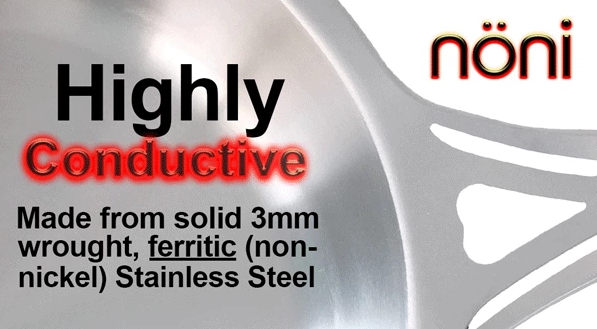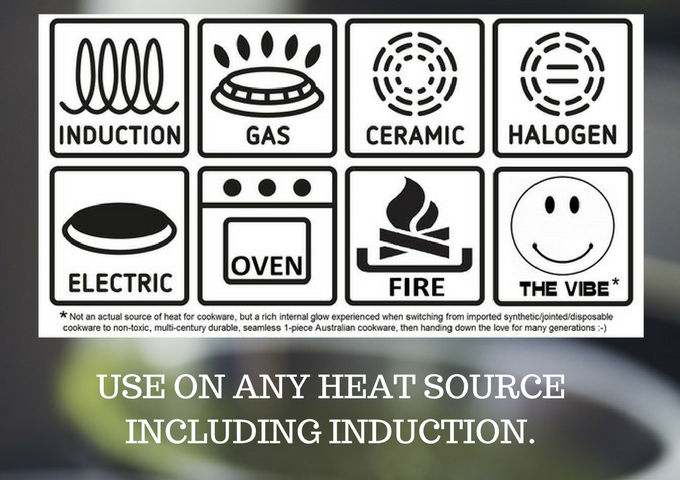Nöni conductivity
The conductivity of our nöni stainless material is a revelation, even for experienced chefs, because everyone is used to the old school tri-ply or disc-base austenitic (Ni-Cr) stainless pans.
We are mechanical engineers with over two decades experience developing equipment for chefs, and we knew it wouldn't be easy to engineer a world-first seamless 1-piece pan that was also more conductive than the old mutli-ply brands. After a lot of R&D we patented our new manufacturing method, and experienced great success with our wrought iron seamless pans among chefs. We were then very fortunate to find a source of this exotic ferritic stainless material in Germany for our Aussie nöni (no stainless is made in Australia), and then find exactly the same spec in the USA for our US production, using 100% USA ferritic stainless steel.
FAQ: How can solid stainless steel be highly conductive - I always thought it was a poor conductor?
Yes, that is true.....if it is the common austenitic stainless used by all the top multi-ply brands. This something entirely different. This is exceptional conductive solid ferritic stainless steel.
Our ferritic (non-Nickel) stainless is almost twice as conductive as austenitic stainless, so it doesn't need clad layers: this is solid conduction direct from (any) heat source through to the food. More conductive than all the old clad multi-ply cookware that has dominated at the top end for decades.
nöni™ is also more durable, with no rivets, welds, screws or joins of any kinds. This is a whole new way to make cookware, wrought from one solid monobloc of highly conductive ferritic stainless, in a new manufacturing process we patented.
Do you have any evidence for this surprising claim?
The university tests are coming up, but meanwhile it is well documented that thermal conductivity for the austenitic stainless steels (eg. 18/10) is a poor 16 W/m-c, while our ferritic stainless is 26 W/m-c.....a significant difference that you will certainly feel in cooking.
We also have 3rd party video experiments clearly showing our superior conductivity versus top multi-ply brands (with equal input conditions) on YouTube here and there. More importantly, because the 'proof is in the cooking', we have extensive real world feedback from chefs and experienced cooks, who always express their surprise at our fast and even conductivity, and how they had to learn to 'turn their burners down' for nöni™. Some is on the launch campaign Kickstarter site, and even more in Facebook reviews and the @solidteknicsusers FB group (see some screenshots at bottom).
What really matters: why our ferritic stainless is loved by chefs and experienced cooks
Our ferritic stainless is loved by chefs because they can feel how conductive our cookware is versus the old multi-ply cookware they've grown used to over the decades, including the top brands. This video clearly shows it: one solid thick monobloc of the right material is more efficient than multiple conductive alloy layers fighting to overcome an insulating final layer.
We can't reveal too much about how it works, but basically our solid ferritic stainless ensures the heat input is conducted directly through to the water/food: not slowed down by a poorly-conducting final layer of austenitic stainless. Chefs don't care about the science: they feel it.
We believe this combination of superior thermal conductivity and indestructible world-first seamless 1-piece wrought construction signals the start of a whole new era in more durable and more efficient stainless cookware.
Non-Nickel ferritic stainless = magnetic = induction compatible!
Ferritic stainless is magnetic (not magnetised), because it is not an alloy with Nickel. Most stainless pans (and benchtops, forks, spoons, etc), are non-magnetic austenitic (Nickel-Chromium) stainless, which is a very poor thermal conductor. Check your stainless around the kitchen: if a magnet doesn't stick strongly, it is austenitic. A concern with austenitic cookware is that studies have found Nickel leaches into your food, particularly the first few cooking cycles, and with acidic foods (when new you should boil 4 batches of water and discard: by nature of migration of the ions, most of the leaching happens in the beginning).
Ferritic stainless is nearly twice as thermally conductive as austenitic stainless, so you can turn your burners down and use less energy, on any heat source!
Reviews
Below are posts shared by nöni cookware owners onto our Solidteknics Cookware Lovers Group on Facebook! It's true that the 'proof is in the cooking'! Though it is quite simply that our highly conductive ferritic is superior to clad stainless steels because they are always fighting the internal final layer of austenitic stainless, which is nearly half as conductive as our ferritic. The fast conduction of nöni is even more obvious on induction, because it is one solid conductive monobloc, right through to the food. But we still win on gas, or any heat source because of the fundamental conductivity differences.




